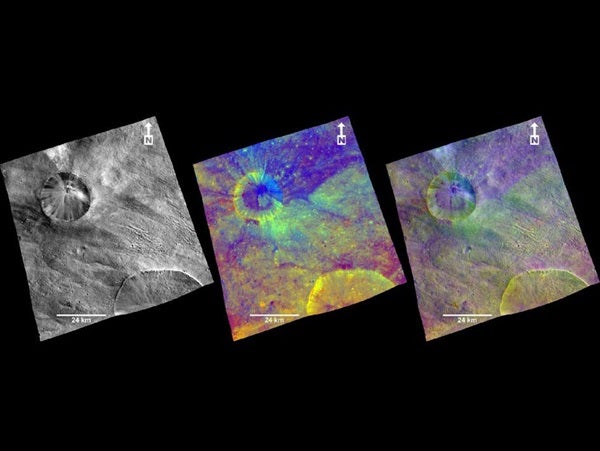Images from Dawn’s framing camera and visible and infrared mapping spectrometer, taken 420 miles (680 kilometers) and 130 miles (210 kilometers) above the surface of the asteroid, show a variety of surface mineral and rock patterns. Coded false-color images help scientists better understand Vesta’s composition and enable them to identify material that was once molten below the asteroid’s surface.
Researchers also see breccias, which are rocks fused during impacts from space debris. Many of the materials seen by Dawn are composed of iron- and magnesium-rich minerals, which often are found in Earth’s volcanic rocks. Images also reveal smooth pond-like deposits, which might have formed as fine dust created during impacts settled into low regions.
“Dawn now enables us to study the variety of rock mixtures making up Vesta’s surface in great detail,” said Harald Hiesinger from Münster University in Germany. “The images suggest an amazing variety of processes that paint Vesta’s surface.”
At the Tarpeia Crater near the south pole of the asteroid, Dawn imagery revealed bands of minerals that appear as brilliant layers on the crater’s steep slopes. The exposed layering allows scientists to see farther back into the geological history of the giant asteroid.
The layers closer to the asteroid’s surface bear evidence of contamination from space rocks bombarding Vesta. Layers below preserve more of their original characteristics. Frequent landslides on the slopes of the craters also have revealed other hidden mineral patterns.
“These results from Dawn suggest Vesta’s ‘skin’ is constantly renewing,” said Maria Cristina De Sanctis from Italy’s National Institute for Astrophysics in Rome.
Dawn has given scientists a near 3-D view into Vesta’s internal structure. By making ultra-sensitive measurements of the asteroid’s gravitational tug on the spacecraft, Dawn can detect unusual densities within its outer layers. Data now show an anomalous area near Vesta’s south pole, suggesting denser material from a lower layer of Vesta has been exposed by the impact that created a feature called the Rheasilvia Basin. The lighter, younger layers coating other parts of Vesta’s surface have been blasted away in the basin.
Dawn obtained the highest-resolution surface temperature maps of any asteroid visited by a spacecraft. Data reveal temperatures can vary from as warm as –10° Fahrenheit (–23° Celsius) in the sunniest spots to as cold as –150°F (–100°C) in the shadows. This is the lowest temperature measurable by Dawn’s visible and infrared mapping spectrometer. These findings show that the surface responds quickly to illumination with no mitigating effect of an atmosphere.
“After more than nine months at Vesta, Dawn’s suite of instruments has enabled us to peel back the layers of mystery that have surrounded this giant asteroid since humankind first saw it as just a bright spot in the night sky,” said Carol Raymond from NASA’s Jet Propulsion Laboratory in Pasadena, California. “We are closing in on the giant asteroid’s secrets.”










